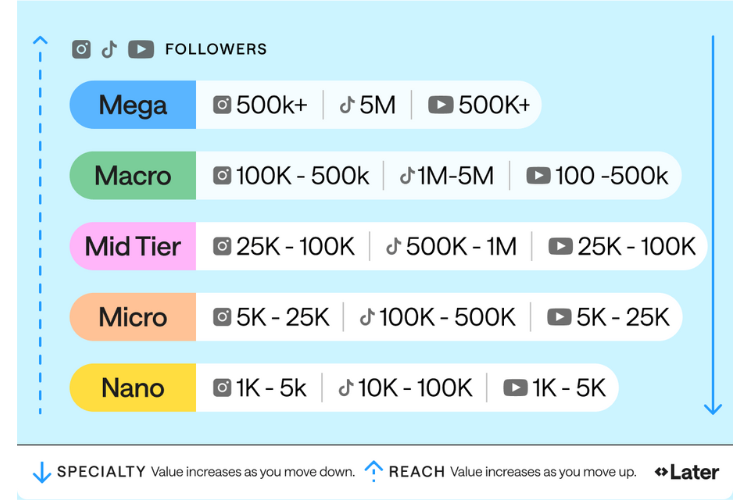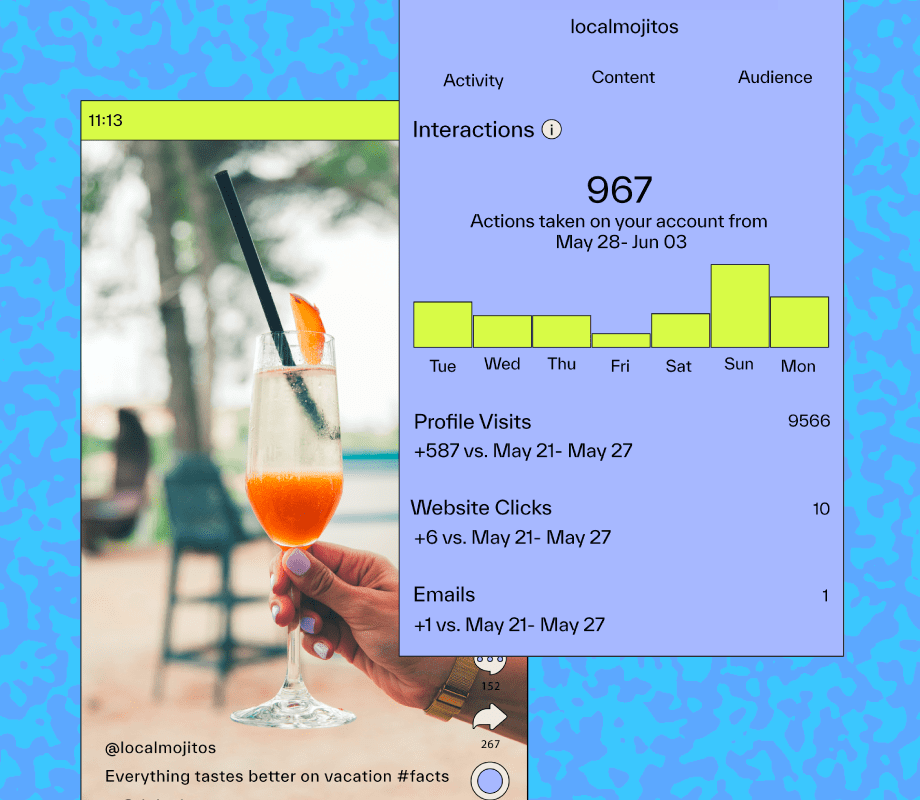The holy grail of influencer marketing is a targeted, engaged audience who deeply trusts the recommendations a creator makes.
Want that for your campaigns? Work with micro influencers.
Creators with smaller audiences can deliver a huge ROI for businesses—but first, it’s crucial to understand who micro influencers are and how they fit into the broader landscape of influencer marketing.
Table of Contents
Join over 1 million marketers to get social news, trends, and tips right to your inbox!
Email AddressWhat Is A Micro Influencer?
A micro influencer is a creator who has between 5k and 25k followers on YouTube or Instagram, or 100k-500k followers on TikTok.
These creators will often have a specific niche topic, such as a goth aesthetic rather than general beauty tips or lifestyle tips for trans women in tech.
Having a defined focus allows micro influencers to create content that resonates more strongly with their followers, resulting in higher engagement and more trust between creator and audience.
Other Influencers Types vs. Micro Influencers
Influencers are categorized based on follower count and engagement. In addition to micro influencers, there are:
Nano Influencers: 1k-5k on YouTube or Instagram, or 10k-100k on TikTok
Mid-Tier Influencers: 25k-100k on YouTube or Instagram, or 500k-1M on TikTok
Macro Influencers: 100k-500k on YouTube or Instagram, or 1M-5M on TikTok
Mega Influencers: 500k on YouTube or Instagram, or 5M+ on TikTok

What are the Benefits of Working with Micro Influencers?
Micro influencers are a key part of a broader influencer marketing strategy — here are the benefits you’ll see from working with smaller creators.
They Connect Your Brand With Niche Audiences
While mega influencers might have millions of followers, not all of them are going to be in your target audience.
More to the point: is it worth the cost? For example, Kim Kardashian commands over $2 million per sponsored post—are you confident her audience and engagement style could generate more than $2 million in sales for your brand?
Micro influencers help address this problem because they are more segmented and niche. When you work with them, you’re getting access to a more targeted audience (or at least a more targeted interest group) than you otherwise might.
They Typically See Higher Engagement Than Other Influencers
The typical macro influencer has an engagement rate of about 4.69% on Instagram.
According to data team at Later, micro influencers have a 9.92% Instagram engagement rate – almost double that of macro influencers!
A higher engagement rate with a micro influencer combined with their more niche and targeted audience could result in a significantly higher campaign ROI.
They Can Be More Cost-Effective
The average micro influencer has a cost per engagement (CPE) of $1.30—the Cost of the Total Incentive Received by the Influencer/Total Engagements of an Activation—across Instagram and TikTok.
A macro influencer? Over 20% higher at $1.59 CPE.
This might seem like a very small difference, but it adds up when you’re talking about even mid-sized marketing spends.
They Can Be Easier To Work With
Macro and mega influencers may have built a following for other reasons that pull their time or attention. They might also have large teams with gatekeepers that stop brands from reaching out.
Smaller creators, on the other hand, are often easier to connect with. Many, for instance, respond to their own DMs! This can make starting (and sustaining) a relationship much easier for brand and social media teams.
Learn more about how you can work with Micro Influencers and successful brand stories like the one with Sleep Aid Brand and Trident Gum!

Common Misconceptions About Micro Influencers
Influencer marketing is rife with misconceptions, but there are a few that specifically apply to micro influencers.
1. It’s Hard To Find High-Quality Micro Influencer Partners
Some brands believe that because micro influencers have smaller audiences, you can’t find them.
However, the evolution of social media makes it easy to go down a “rabbit hole” of your favorite content, which surfaces smaller creators. You can also find them with Later’s database of pre-contactable influencers ready to work with brands.
2. You Can’t Scale Easily
There’s another belief among some brands that it’s easier to work with one big influencer compared to multiple smaller ones.
First, your competitors don’t believe this — a Global 2024 study found nearly two-thirds (62.4%) of brands have worked with more than 10 influencers.
Second, the real issue is managing communication, campaign development, contracts, and payments; that’s easy when you have the right tool like Later Influence keeping everything in a single platform.
3. Too Many Influencers Means A Diluted Message
Some brands are concerned that working with multiple influencers means their posts will actually be competing against each other in the algorithm.
This is simply not true.
You can have multiple micro influencers in the exact same niche and still not have significant audience overlap because of other factors, such as geography.
Even if influencers have overlapping followings, social algorithms show people content they like—meaning they are more likely to see your brand via multiple influencers.
The key is to work with each influencer to not just share the same message, but create content that matches their style, geography, and other factors.
Statistics About Working With Micro Influencers
Here are some key statistics to know about micro influencers:
1. TikTok Has the Highest Average CPA for Micro Influencers; Instagram Posts Have the Lowest CPA
Instagram posts might be your most cost-effective option for working with micro influencers: the average post costs $233 compared to $300 for an Instagram Story and $1,692 for a TikTok video.
If you can access the same audience on a less expensive platform, the ROI of your influencer marketing campaigns could shoot up.
Download the latest Influencer Marketing Benchmarks Report to get industry insights for your next campaign!
2. Small Audiences = Bigger Returns
According to HubSpot, nearly half (47%) of marketers had success working with micro influencers in 2023.
Working with smaller creators often resulted in more audience connections and helped brands achieve more cost-effective uses of their influencer marketing budgets.
3. Social Media Sells
Research from Retail Dive suggests the majority (85%) of Gen Z say that social media has impacted their decision to buy products, with most getting key information from Instagram and TikTok.
Your brand should have some visibility on Instagram and TikTok, especially if you’re targeting a younger audience.
4. Gen Z Trusts Creators More Than Their Peers
Gen Z wants to emulate influencers instead of those they know IRL.
For example, The Drum found that 45% of people surveyed want to wear brands they’ve seen on their favorite creators, while only 18% want to wear brands their friends wear.
Our Favorite Micro Influencers
Micro influencers may not be instantly recognizable, but that doesn’t mean they don’t have trust with their audience.
Here are a few of our favorite micro influencers:
@Beaux.Florals: A flower-loving creator who owns a wedding florals company.
@LynnetteJoselly: Fashion creator who owns Bella Kurls, hair extensions for curly-haired people
@TeelyTheFoodie: Vancouver, BC-based food creator
@DaveyAndSky: Nova Scotia-based travel YouTubers and creators
@SellingUpAndBuyingAChateau: A German-Australian couple renovating a château they purchased in the French countryside
@GaysWhoGarden: A couple from Texas posting about their gardening projects
@CentsOfIndependence: A personal finance creator who posts about the FIRE (Financial Independence, Retire Early) movement
Each of these creators uses a different business model, showcasing the multiple ways that micro-influencers work for themselves and brands.
This is why a high-quality influencer management platform is essential when working with smaller creators—it helps keep every little detail documented and referenceable. Learn how you can use Later to find the best influencers for your next campaign!
How Do Brands Work With Micro Influencers?
Working with micro influencers can take a few different paths—here are a couple of examples to give you inspiration.
Targeting Two Personas For A Sleep Aid Brand
A sleep aid supplement brand wanted to build its product awareness and chose to leverage micro influencers to help with specific audience targeting.
Working with a variety of micro influencers, the brand was able to create highly-targeted content for both a kids campaign (ages 4+) and an adults campaign (ages 25-35).
By partnering with different creators through Later Influence, the campaign included multiple types of content, including:
Use case based (e.g. back to school)
Culture based (e.g. Sleep Awareness Month)
The team also repurposed content across influencer accounts and their own branded accounts.
The result: Nearly 100,000 engagements and 600,000 impressions, driving significant growth for the brand.

Trident Drove 1.7 Million Impressions For Pocket Packs
The Trident gum company launched a new product in 7-Eleven stores and wanted to drive impressions and clicks to the 7-Eleven store locator.
The campaign focused on creating highly-stylized visuals that showed Trident gum in a variety of lifestyle use cases, for example fresh breath for a date or enjoying a piece of gum in the park.
Trident sourced influencers with Later Influence, pre-vetting them to be family friendly and avoid overly-contentious topics in their content.
The result: 1.7 million impressions and an average engagement rate of 7.7%, driving thousands of clicks for the campaign
Micro Influencers Can Drive Significant ROI
Micro influencers can lead to a positive ROI and can be valuable, cost-effective partners for influencer marketing campaigns.
A key challenge, though, is sourcing the right partners for your brand and your campaigns. Then it’s about managing the whole process, from initial reach out to final payment.
That’s where tools like Later Influence can help.
There are over 10 million influencers in Later’s Influencer Index, many of whom are micro influencers, which brands can enlist for their campaigns.
Not only does the platform help you find influencers, but work with them: communication, contracts, briefs, and payments all in one platform.
Book a Demo with Later Influence to find out how the platform can supercharge your micro influencer strategy.




